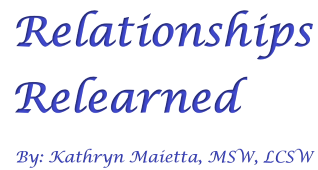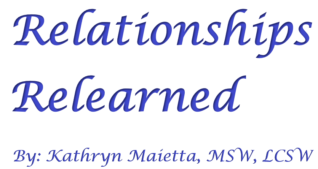As part of Domestic Abuse Awareness Month, this blog will focus on domestic abuse. Perhaps a little background about my involvement in the field of domestic abuse would be helpful.
In the early 1990s I was working as a social worker in the Penobscot County Jail (Bangor, Maine). One day I was talking with a man who was in jail on his 8th arrest and 7th conviction for domestic abuse against his intimate partner. It was then that I decided that if I could teach men how to be non-abusive, maybe there would be fewer victims.
In working with the local domestic abuse program, Spruce Run (now Partners for Peace), https://www.partnersforpeaceme.org/ I started developing a batterers’ intervention program for men who were abusive to their intimate partners. It took me 3 years of planning and community collaboration to get this program in operation. I was the Director and Co-facilitator of the Penobscot County Batterers’ Intervention Program (“BIP”) for 23 years, October 1995 to October 2018 when I transitioned from my day job to a new adventure (writing).
In addition to my co-facilitating a BIP, I was involved on a state wide level focusing on ending domestic abuse in Maine. I was appointed by five governors to the Maine Commission against Domestic and Sexual Abuse. https://www.mcedv.org/wp-content/uploads/2018/06/2.19.16-LD150-Final-Report.pdf Since its inception 20 years ago I was the batterers’ representative to the Maine Homicide Review Panel. https://www.maine.gov/ag/docs/DVHRP-FinalReport%2010.2.2018.pdf For many years I was co-chair of the Maine Association of Batterer Intervention Programs. Within Maine and nationally I have presented at conferences on issues relating to domestic abuse. In 2018 I was honored to receive the Champion of Change Award from the Maine Coalition to End Domestic Abuse. https://www.mcedv.org/
Terminology
Is abuse between two people called “domestic abuse”, “domestic violence” or “intimate partner violence”? When using the phrases “domestic violence” or “intimate partner violence” there is a focus on the violence part of the relationship. In my experience, physical violence is only a small part of the pattern of abusive behavior. Emotional abuse is much more prevalent and leaves psychological scars deeper than most physical scars.
It was always interesting to me that men in the batterers’ intervention program were willing to admit and discuss their physical violence, almost as if it was “more manly” to be violent. It seemed to be easier for them to rationalize their behavior by saying, “I hit her because she ….” Many times men wouldn’t even recognize that their criticism, threats, intimidation, harassment and put downs of her parenting skills as being abusive! The men would talk about their partners being “sensitive”, not as being victims of emotional abuse!
In any of my writings about the use of power and control in an intimate relationship I will always use the term “domestic abuse”. It is the accurate term.
When I speak about men who are abusive to their intimate partner, I use the term “batterer”. In my experience, it is a term batterers don’t really like, but they clearly understand. If batterers are taking responsibility for their behavior, they understand the term fits. Victims deserve for the behavior to be called what it is.
When I speak of batterers, I will always use the pronoun “he”. When I speak of victims of domestic abuse, I will always use the pronoun “she”. Not because victims of domestic abuse cannot be men, but because my area of expertise is working with men who are abusive to women. It is what I spent decades doing. It is what I know.
Definitions
In the batterers’ intervention program I developed, directed and co-facilitated, the working definition we used always used was:
Domestic abuse is a series of acts that:
• Prevents the victim from doing something she wants to do and/or
• Forces the victim to do something she doesn’t want to do and/or
• Causes her to feel afraid.
Types and Examples of Physical, Emotional, Sexual and Verbal Abuse
Physical Abuse
The following is a very limited list of physical abuse examples:
Contact: slapped her, punched her, grabbed her, shoved her, kicked her, strangled her; pushed her, beat her, burned her, shook her and/or twisted her arm.
Restraint: disabled her car, blocked her exit, took her car keys, prevented her from using the telephone and/or abandoned her in a dangerous place.
Weapons: used weapons against her, kept weapons around to scare her, threatened her with a weapon and/or refused to show her how to use weapons.
Emotional Abuse
The following is a very limited list of emotional abuse examples:
Criticism: called her names, ridiculed her, made accusations against her, criticized her friends, criticized the way she does things, and/or criticized the way she looks.
Economic Abuse: withheld money / financial support, made her account for her spending, overspent on himself and/or had her lie to creditors because of him.
Emotional Withholding: ignored her, didn’t follow through on an agreement, lied to her, withheld emotional support, interrupted her and/or changed subjects.
Harassment: made uninvited visits, followed her around, embarrassed her in public, didn’t leave when she asked him to and/or bothered her at work.
Intimidation: used sarcasm at her, claimed to be “the authority”, swore at her, used his size to intimidate her, drove recklessly to scare her and/or punched walls.
Isolation: didn’t tell her his plans, ignored her; prevented/made it difficult for her to see or talk to friends or friends, and/or made jealous comments or accusations.
Pressure Tactics: manipulated logic to his benefit, shouted “over” her, rushed her to make decisions and/or used guilt or accusations to get her to do what he wanted.
Threats: threatened to physically harm or kill her or her family or friends, used angry and/or threatening expressions with his face and/or used trivializing gestures.
Used Children: undermined her authority with the children, asked a child “to spy” on her, denied paternity and/or used visitation as an excuse to check up on her.
Sexual Abuse
The following is a very limited list of sexual abuse examples:
Contact: pressured or used force for sex, withheld sex from her, pressured her to do things sexually she didn’t want to do, had affairs and/or used sex to “make up”.
Coercion: pressured her to look at pornography, compared her body to other women’s and/or compared her sexual performance to that of other women.
Male Privilege: got in the “last word”, pressured his victim to fit into sex role stereotypes and made decisions in the family without input from his victim.
Verbal Abuse
Verbal abuse is a series of statements, or the use of a particular tone of voice, that are meant to be coercive: “You brought this on yourself.” “It’s all your fault.” “I saw you looking at him.” “You can’t do anything right.” “What goes on in this house, stays in this house!” “No one will ever want you but me.” “I didn’t mean it.” “It’ll never happen again.” “I’m going to kill you.” “If you leave me, I will tell everyone you are a lesbian.” “You don’t know how to do anything right.” “If I can’t have you, then no one will!”
Effects of domestic abuse on relationships
Domestic abuse erodes everything that is important in creating and maintaining a successful healthy relationship. Domestic abuse prevents healthy communication and destroys any trust or respect she may have for her partner, the batterer.
Many times when there are “problems” in a relationship, someone will suggest couples counseling. In my private practice I frequently provided couples counseling. Couples counseling is based on the premise that both people share the blame for problems in the relationship.
Domestic abuse is not a relationship problem! Domestic abuse is destructive behavior chosen by the batterer.
When domestic abuse is identified in the relationship, the batterer and his abuse are the problem. He should not go to anger management therapy, because domestic abuse is not an anger management issue. (See my next blog concerning domestic abuse and anger management scheduled for October 13th.) When abuse is in the home, the couple should never attend couples counseling, because it is not a shared problem and it can be dangerous for the victim. Best practice for intervening with men who are abusive is a batterers’ intervention program. Period. https://www.mcedv.org/wp-content/uploads/2018/06/2.19.16-LD150-Final-Report.pdf
If you are a victim of domestic abuse, or think you might be, please contact your local program for victims of domestic abuse or contact the National Domestic Abuse Hotline @ 1 800-799-7233. https://thehotline.org
If you are a victim of sexual abuse, or think you might be, please contact your local program for victims of sexual abuse or contact RAINN (Rape, Abuse & Incest National Network) @ 1 800-656.HOPE (4673). Or online@rainn.org. https://rainn.org
If you are a batterer, or think you might be, please contact your local intervention program for men who are abusive. If there is not one in your local area, please contact me. I will work with you to find someone who can provide you with the education you need to learn how to stop being abusive.
I hope this blog has provided you with new information that will be helpful to you in all your relationships. If you have any comments or questions about the content of this blog, please contact me: Kathryn@relationshipsrelearned.com
Are current life situations causing you stress? Do you need a plan or new ideas on how to decrease your stress and anxiety? My book may help: Crush Your Stress: 302 Coping Skills for Managing Your Stress.








